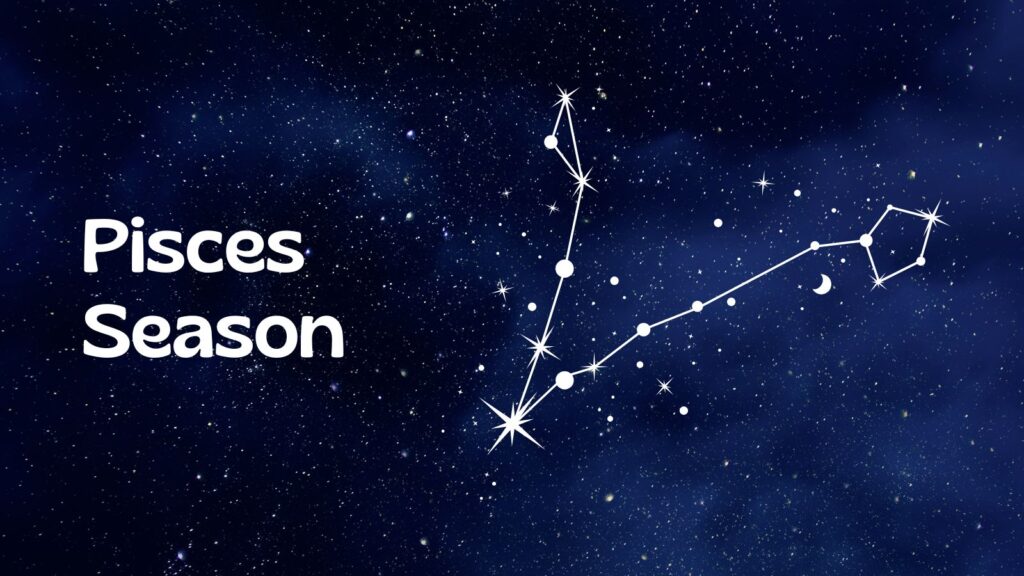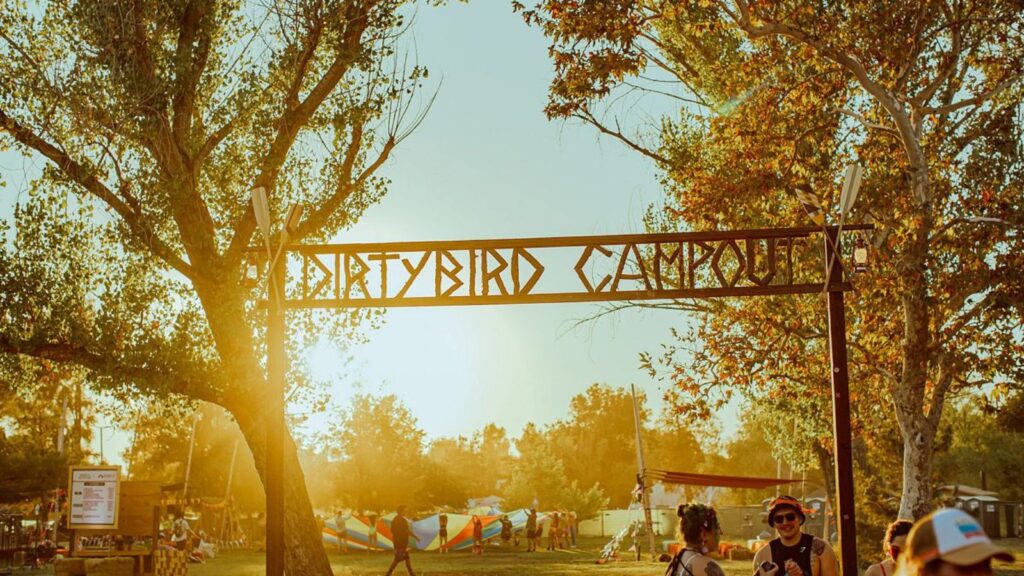Genesis P-Orridge is without a doubt one of the most enigmatic artists of our time. For starters, Genesis’s late 1970’s band Throbbing Gristle is credited with pioneering the industrial music genre while h/er next musical project, Psychic TV, would later evolve into a fellowship of artists and occultists called Thee Temple of Psychick Youth, which was heavily influenced by the ideas of William Burroughs, Brion Gysin, Aleister Crowley and Austin Osmond Spare.
Add the that the fact that in the late 1990’s GPO would embark on the Pandrogeny Project, undergoing multiple, significant body modifications along with lover Lady Jaye in order to “become each other, to become one,” and that in 2010, s/he published a “new manual on practical magick” called Thee Psychick Bible, and you quickly realize how truly singular Genesis is as both an artist and human being.
But for Genesis, art and life are not separate. Having lived for many years in Nepal’s Kathmandu Valley, the non-dualistic way of life of the Tibetans would influence Genesis to live a more fully integrated existence and to communicate this way of being through creative work that western eyes might find revelatory. Genesis’s current exhibit ‘Try to Altar Everything” at the Rubin Museum in New York City does just that. According to the museum copy for the exhibit:
For nearly half a century Genesis Breyer P-Orridge has been questioning the meaning and substance of identity through artistic endeavors, willful reincarnation, and physical shapeshifting. Try to Altar Everything, a selection of paintings, sculptures, and installations, will explore the ways that Hindu mythology and Nepal’s Kathmandu Valley have influenced the artist and h/er work.
Reality Sandwich caught up with GPO for an interview to discuss these themes and attempt to penetrate more deeply into the mind of this truly enigmatic figure.

The reader should note that as per Genesis’s efforts to apply William Burroughs’s “cut-up” technique to the body itself, transcending the limits of being trapped in a single “meat suitcase” and uniting with the body and spirit of h/er lover Lady Jaye, Genesis often uses the pronoun we rather than the typical “I” that the rest of us use. It can be a little confusing at first, but simply thinking in this way makes us think differently about what it means to be human.
Mitch Mignano: What first brought you to Kathmandu, Nepal?
Genesis P-Orridge: We began Psychic TV in 1981, which was always interconnected with Temple ov Psychick Youth. That was because we wanted to be more than just a band. When a band is trying to do serious music with real messages, ideas, and concepts, it can be very frustrating. There’s more to this than just trying to have a hit record. And as a consumer who’s interested in more, you’re hungry for more information. We wanted to be the band that supplies the maximum extra information.
We set up a worldwide network. At one point it was approximately ten thousand people, of whom around 3000 were very active in different ways. That lasted from ’81 to ’91. Somewhere around ’89, we were talking to the person that ran a Temple of Psychick Youth in England. He told us about a Tibetan Buddhist monastery in Scotland he’d been going to called Samye Ling. He originally went because they had programs for junkies, and he wanted to understand why he was addicted to various opiates. He ended up becoming part of the Tibetan Buddhist belief system.
He said, “You should go Gen, you’d like that. You’re always saying how you’re interested in Tibetan culture.”
So in the back of my mind I knew there was this monastery, but that was about all. Every year, with my two daughters, Caresse and Genesse, we would hire a little camper and travel around Britain, finding ancient prehistoric sites the equivalent of Stonehenge. We would wander around almost aimlessly and when we found one of these ancient sites, we would hang out there for two days, meditate, and just be. Just be away from all the usual Western culture.
In the late summer or early winter of 1990, we were doing that in Scotland. It was the middle of the night, pitch black, and we were lost, driving in the middle of all these forestry plantations. There were no street signs or street lights anymore, no freeways, just lanes.
We saw this figure hitch-hiking ahead on the road. It was some man in grey robes and a hood. The obvious thought was, that’s some kind of priest, or a monk. So we pulled over and asked where they were going.
The person said “that way” and pointed up the street. We said yeah, but where are you going? He said that way. We said get in and we’ll take you as far as we can. So he got in the back with my two daughters and we drove for a while.
Suddenly, his voice from the back went, “This is where I get out.”
We looked. And there was nothing there. Just trees and blackness. No buildings, no lights, no nothing. We pulled over and out this person got. We turned around to say, “It was nice meeting you,” and there was no one there. We said to the kids, “Where did that guy go?”
They said they didn’t know, he just got out. We looked and there was no sign of him in any direction. That was a bit spooky, you know?
We kept going straight. After a few hundred yards, we saw lights in front of us on the other side of the road. As we got nearer, we saw Tibetan prayer flags in the trees, a driveway, and a parked car with lights on. We thought, that looks like it could be the monastery our friend told us about years ago. What else could it be? Whatever it was, it looked friendly compared to the total black.
This nun came running out of the building, rushed up to us, and knocked on the door. She said, “We’ve been waiting for you.” We went, “What do you mean you’ve been waiting for us? We don’t even know where we are.” She said, “Yeah, Lama Yeshe is waiting to see you and have dinner.”
We’re like, what the fuck is she talking about?
We went inside and there’s about 100 people — monks, nuns, and those who weren’t fully initiated — seated at these long table. At the head of one was Tibetan monk with a bald head and big grin. In front of him were two seats to either side for my two children, me, and the children’s mother. Everybody just sat there waiting for us to arrive.
Was this that person in robes? My thought is that Lama Yeshe, the retreat master, lead us to the monastery for his reasons. Very spooky.
We sat down at our places, ate with everybody, and stayed for a few days. We did meditations, prostrations, and relaxed by this wide, shallow little river. It was a beautiful spot. We got to know Lama Yeshe.
One day he said, “Come and talk to me.” We went to his room in the building. He sat cross legged in his robes on these beautiful pillows and rugs, watching cartoons on the TV and laughing all the time.
He said, “Genesis, you are not happy with your life right now, are you.”
“Um, no.”
“You’re kind of sick of the rock’n’roll business, and you don’t know what to do. Is that right?”
“Yeah, that’s right.”
“Go to Kathmandu. We have a monastery there and we think you would really like going there and being with the people in Kathmandu for a while.”
We realized it all fit together. The friend who told us about Samye Ling, the figure that said “that way,” Lama Yeshe and them expecting me. It seemed like this was something that we were really supposed to do.
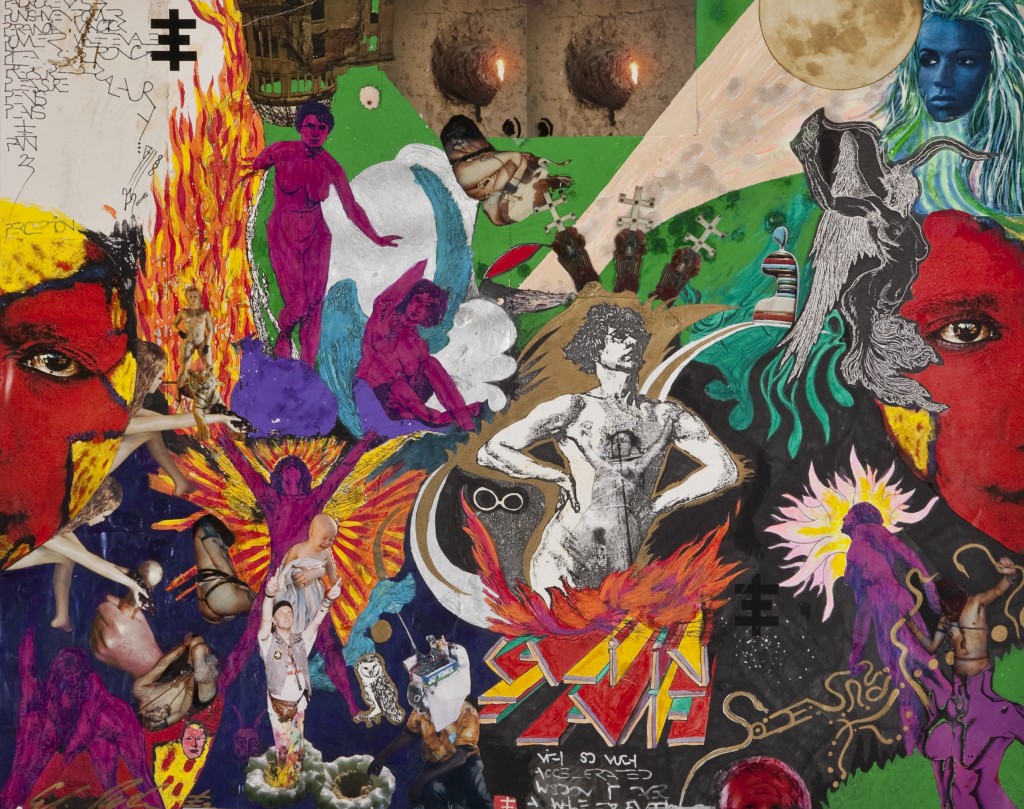
So we started planning to go to Kathmandu. At that time, we were friends with the people at the October Gallery in London, one of the buildings that the Synergias have.
Someone we knew that was involved with them at the time was Evans. We told her about what happened, and she told us about a hotel they had in Kathmandu, the Vajra Hotel. “I’m sure we can give you a special rate,” she said, “it’s a really nice hotel, and it’d be a good base of operations for you.”
We said ok, let’s do that. We’d been going to the October Gallery regularly, doing exercises, learning about Gurdjieffian theories, and so on.
Before we left for Kathmandu, we put out a call to everyone in Thee Temple ov Psychick Youth. We told them we were planning on going there, and that the monastery we were working with was planning to do a soup kitchen to help Tibetan refugees, beggars, and lepers survive through the winter. We asked them to donate warm clothes and anything else they could to help.
And the fans did. They sent loads of beautiful things which we put into a great big package and shipped with us when we went to Kathmandu in the fall of ’91.
Off we went. Myself, my then spouse, and my two children had an adventure to Kathmandu, thanks to Lama Yeshe. We stayed in the Vajra Hotel, made contact with the monastery, and, as much as we could, financed this soup kitchen.
Every morning, at about 5am, we would get up with the children and walk down to Boudhanath Supta, one of the very famous stupas in Kathmandu. We would make great, big tourines of rice and dahl with the monks. Anyone who sat down around the stupa at 7 to 8am would be fed with rice, dahl, and clean water. We did that about twice a day every day, right through the winter, for three months or so. Three hundred to five hundred people twice a day paid for through Thee Temple Ov Psychick Youth.
A few days before we set off to Kathmandu, Evans got in touch with me. She told me that when she lived in Kathmandu with the Vajra Hotel people, she got to know a guy called Trilochan. He was an amazing, wild, psychedelic Nepali guy that got busted for drugs and sent to prison. She hadn’t heard from him since — it’d been a few years. She said she’d be grateful if I could find out what happened.
One morning, my daughters asked for an English breakfast, so we took them to Thamel, a tourist area. As we’re thinking that no place there would serve an English breakfast, we saw a restaurant called “Third Eye.” We immediately thought of William Burroughs and Brion Gysin’s “The Third Mind.” Third Mind/Third Eye was as good as any reason, so we tried it. They did serve us an English breakfast.
No one else was in there for a while. Then this really tall, big guy, like a giant, walked in looking a bit nervous. He sat by himself and kept looking both ways out the window.
We’re wondering who he is. He looked like someone trying to do a deal. When he ordered food, an English breakfast, we heard that he was English. So we walked over and said, “Couldn’t help hearing that you’re English. Hi! What’s good to do in Kathmandu?”
He introduced himself as Big John. It turned out that he was involved with Mr. Knife, a drug smuggler that got busted for marijuana. After we sat back down with the kids, a short, skinny Nepali guy, really speedy and squirrelly, came in and sat with him. As they chatted, we remembered Evans asking us about Trilochan. Since this guy knew Big John, he might know him too.
So we asked Big John’s friend if he’d heard of a guy named Trilochan, and he went really quiet and still. He asked “Why do you want to know?”
We told him. He said “I’m Trilochan. I got out of prison this morning.”
That’s how I fell in love with Kathmandu. What are the odds, right? To this day, we’re good friends with Trilo. We call each other soul brothers. That was a really auspicious morning.
Wow, nice work there! Let me go a bit deeper and ask what it was that you saw in Hindu or Buddhist mythology that drew you to identify with it?
During the 50’s in England, if you did well with exams and were particularly bright you could be bumped up a year. At nine years old, we were already in a class called eleven plus. We were in it up to eleven years old, so by that point we were a bit bored with the basic program.
Also, we were always ill with asthma, and spent three months of every year sick in bed. How we dealt with being alone all the time was to read books. Thank goodness my parents were both avid readers too, my father especially. He had a really good library of books, and nothing was censored. He let us read anything. It didn’t matter if we understood it or if it was unlikely material for my age group. One day he said, why don’t you read this book. It was Seven Years in Tibet by Heinrich Harrer. We read it and were absolutely fascinated.
That’s when we became infatuated with the mysterious and exotic world of Tibetan Buddhism and the Himalayas. That was implanted early on. We continued to read anything about Tibetan Buddhism and anything related right through the 60’s. As we got more into music, we became fascinated with Tibetan music.
It stayed with me. The very first Psychick TV album “Force the Hand of Chance” had a bonus album with it, “Themes One.” There’s a track which is 23 minutes of Tibetan thigh bone trumpets. One of the things we loved about Tibetan music was that you didn’t have to be skilled at an instrument to play it. From our understanding, when a new monk arrived, the older monks would assign them an instrument based on their personality. We loved this idea that you didn’t have to know how to play something in order to play it. It was about your spirit and what you were going to draw out of yourself that was relevant. The sounds you made would always be appropriate to your spiritual being.
Rules and regulations, structures and traditions — go fuck yourself. We brought all of that to bear with Throbbing Gristle in industrial music, of course. To this day we can’t play anything. We couldn’t even play three blind mice on any instrument. We don’t even know how to tune anything, but we’ve made over 300 albums. Go figure, the Tibetans were right.

Some time in the 80s, saw a sign that said Dr. Alan Presence is giving a talk and demonstration of Tibetan singing bowls and thigh bone trumpets at some small, cultural space. We went and recorded it. We were fascinated by Tibetan instruments, the spirit of everything and the frequencies they were using. We learned that the frequencies could have a direct impact on what endorphins were released, impacting how they were utilized. For instance, we still have a singing bowl he got for me that’s meant to destroy demons, which means migraines. It works. We’ve used it for people.
One day, while walking down Portabello Road with a friend, we suddenly got this strong urge to go inside a closed shop. The door was open. It looked completely empty, but in the back there were a couple of stores that still had people. There was a guy with a couple of singing bowls on display that looked familiar. We told him about the talk with Dr. Alan Presence, and he said he was Dr. Alan Presence. Of course you are. Of course we walked into this derelict shop and you were there.
We told him we wanted thighbone trumpet, and he pulled one out from under the counter. We still have it. It’s at least 300 years old. It belonged to a Tibetan monk. That’s why we’re so in love with Tibet — things like this happen all the time.
When we got off the plane in Tibet, it was like we’d taken psychedelics. The thing that impressed and stays with me to this day was that there was no separation between devotion and the spiritual with mundane daily activities. They were all fully integrated, equal significance. Eating something nourishing was just as valid as doing a puja to heal somebody, or chanting for an hour, or listening to teachings from a wise monk. Everything was fully integrated on every level. You can walk down the street and see somebody doing a sacrifice over a shiva lingam, other people buying and selling things in the grocery shop, and someone else rushing to work in their little office power suit. Nothing is out of whack. Everything is in balance. Nothing looks out of place. Nobody looks askance at whatever else is going on.
You get to the burning ghats and they’re burning people and sweeping ashes into the river. There are people up the rivers doing their laundry. Other people who are bathing. It’s all part of this wonderful psychedelic process of energies where everything is equal, and nothing has more or less significance than anything else. Like the path of Aghori, the path of no distinction.

Now let’s bring a bit of Burroughs and Gysin into the conversation. In your experience, how are you able to engage with mythological systems or cosmologies while still maintaining your personal autonomy?
We do not call ourselves Buddhist or Hindu. We do not specifically follow any deities or mimic any rituals. The real point is the essence of it. In the West it’s often called synchronicity, but we feel it’s far more potent than that. You can build a relationship with a non-physical world, probably the same world as quantum mechanics. Beneath everything there are relationships with the universe, with particles, with the so-called laws of physics, with transcendental thought, concepts of mortality and immortality, existing and not existing, the physical and the non-physical.
Somewhere amongst all of the search that we’ve lived, there is this basic core, what we call the “of course factor.” Of course we met Lama Yeshe. Of course he said go to Kathmandu. Of course there was a hotel. Of course we met Trilo, and so on. The “of course” factor is evidence of the rightness in this apparently mysterious path. The path is always towards wisdom. As Brion Gysin said to me when we became friends, wisdom can only be passed on by the touching of hands.
There is a sculpture in the Rubin Museum about that. It’s a bronze cast of my right arm from the elbow down in the position of shaking hands. It says next to it, “Wisdom can only be passed on by the touching of hands” and people can literally hold my hand. Hopefully it will get shiny over the years, like those buddha and saint statues that get shiny where people kiss or rub them. We’re not saying we’re a saint. We’re deliberately referencing the idea of repetition and submission to the idea of continuity passed on from person to person throughout the story of our species.
Now, if we can go in a different direction… There is a chasm between the wisdom in the East and the way we exist in the West. And you see that evolving, the either/or dichotomies, and duality in general.
They have to be extinct.
How did we get caught up in this trap of good and evil, who’s to blame?
When somebody’s parents have sex and an egg is fertilized, you immediately begin the story of either/or. Not always, but nearly. People start saying, is it a boy or a girl? Either/or. Then they start deciding what name it should have, their expectations of it, what it will become… and it’s not even out yet. This poor little slug hasn’t come out the vagina yet and it’s hearing all this, because you hear through skin. People program you with their desires, expectations, fears, prejudice, disappointment in themselves and their lives. That’s being funneled at us from the very beginning, and continues once people emerge into the physical world. That’s the beginning of the problem.
It continues when you begin socializing and making friends. They’re boys or girls, nice or not nice. You get the pressure of peer groups, other people’s opinions, the media, economics, and so on. There’s a constant pressure as to what you should be or the choices you should make from the very beginning. That’s disastrous in and of itself.
In the early days, when our species was still in caves and there were neanderthals and sapiens and so on, male aggression and strength had a purpose: to perpetuate the species. We needed aggression to protect the next load of children, the food source, etc. It fit with the environment. It was necessary for the clan to survive.
Over thousands of years, we’ve developed an ever more sophisticated and totalitarian power over our environment. We’ve changed the environment in which humans live. We’ve spent immense amounts of intellectual attention and research to do that, to protect ourselves and build these great big civilization structures. But not many people or cultures have bothered to truly develop the behavioral environment to match.
What you have is a wonderful, sophistical digital post-modern society and environment. But you still have prehistoric behavior patterns where in the “brutal male of the species” is just left there, festering. The evidence is in the fact that there’s been more than one war. When we give talks, we ask people: how could there ever be a second war? How could you look at people dying, bleeding, in agony, and not say “Never again.” People do say it out loud, but they don’t really mean it because they do it again. It’s been going on for tens of thousands of years. We’re out of whack. Something’s wrong.
The male, genetic behavioral patterns of our species are literally leading us to the abyss. We’re trying to apply prehistoric behavior to a completely sophisticated technological environment. It doesn’t work. It can’t work unless we find ways to change behavior. The great question is: is it even possible to change behavior?
The either/or doesn’t work. It’s how we got invested in the work of Aghori, the path of no distinction. The either/or, male/female, black/white, Muslim/Christian, rich/poor – it’s a failed system. How many thousands of years of evidence do you need that it does not work? It has not ended suffering, or violence. Something is wrong with the behavioral imperatives of our species.

Let’s move to one of the more provocative and enigmatic aspects of your life and work- pandrogeny. Jung saw Christ as the archetype of the Self. And Rudolf Steiner professed that the individuation process is the crucible for further human evolution. Do you see pandrogeny as more of a return to a primordial way of being or as a transcendence of individualistic materialism?
Oh god, you’re asking difficult questions! There are so many motives for pandrogeny. The longer we’ve delved into its implications, the stronger we feel that pandrogeny is crucial to a shift in the way our species works. Obviously, with pandrogeny, there’s no longer male or female — there’s just the panderdigm.
If it was possible, we would love for this species to become the divine hermaphrodite, for everybody to be male and/or female, or more than that. Timothy Leary said that this time around you can be anything. You realize that genetics are part of the issue. In a utopian vision, the being can redesign itself in any way it chooses. You can have fur, peacock feathers, or gills and live underwater. I agree with Brion Gysin and William Burroughs that this species, any species, is supposed to expand outwards. But we won’t be able to while we have this great big albatross on our back.
pandrogeny goes so many places once you say the human body is just a physical meat suitcase. Tesla called it a meat machine. Jaye called it a cheap suitcase for the brain. Leary used to say the body was just so the brain could be moved around. The body is not us. The being that we speak with in our own mind, the “I” or “we” depending on how you do it, consciousness, is us. The physical world is where we travel, where our bodies give us a chance to experience sensory moments. But the “I” being is consciousness.
That’s one of the other things that drew me to Tibet. This nation has devoted huge amounts of its population to meditation, travel, and exploration of consciousness. That is the example we should be looking at, and we nearly managed it in the sixties. Human beings are wonderful creatures in potentia, bound and gagged, hypnotized and intimidated and imagining that the world we see through our eyes is real. It’s not. If you can take a little piece of liquid paper to make it vanish, it’s not very real. The world we see outside is an agreement on a really insipid version of potential. We see the Empire State Building out our window, loads of power blocks, projects. How could your species choose to do that to itself?
You know what’s wrong with our vision? We have the space to do something different. Wasn’t it Steiner who said we shouldn’t have square rooms or windows but all curves?
Yes, it was. But this is what we do. We keep running the program.
Yeah. We’re really in a critical point. We have to decide on how we want to evolve. That’s where we got to with pandrogeny. It started out as Jaye and I wanting to be immersed in each other, and hopefully explore different dimensions after physical death in this realm. We realized the implication of it when we looked at genetics. Our bodies had a program to become a particular way, and we wanted to deny that program and have control over what our bodies evolve and look like. Then you realize it’s about evolution. We’re at a point where this species has to decide whether to evolve or implode and go back to the unpleasant dark ages. The odds are high for dark ages, unfortunately, but we do have the option to make a different decision. So while Tibet has its flaws — it was a bit medieval — it’s so fabulous for over 70% of a nation to focus on out of body travel.
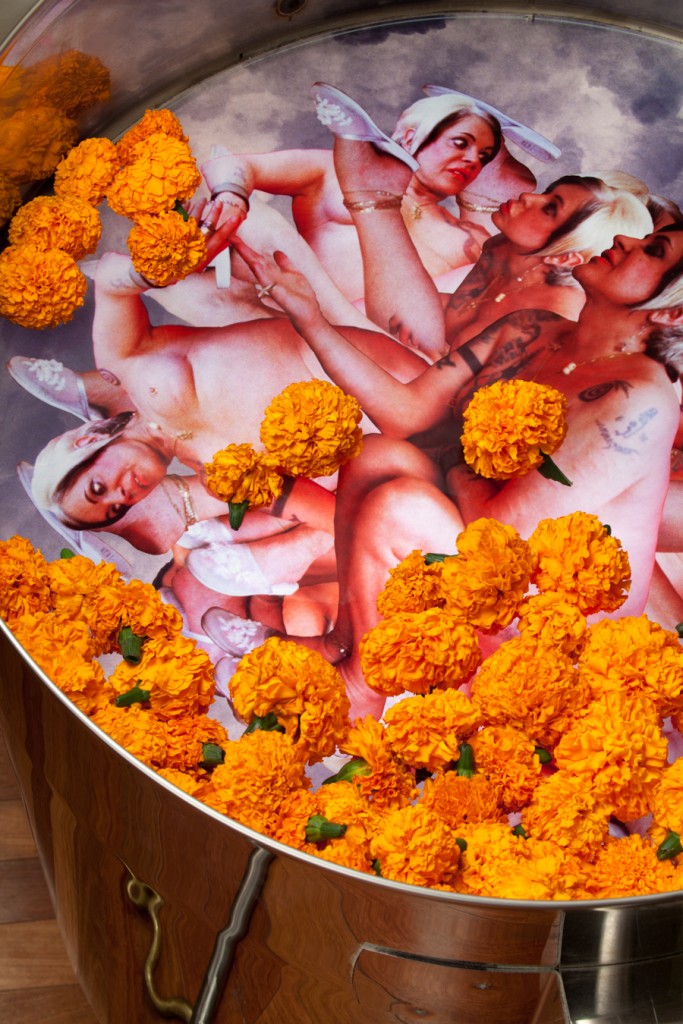
I want to ask you a question about sound and then music. Are you familiar with McLuhan’s work? McLuhan drew our attention to text-based consciousness as an imperial program, where the priests control the knowledge in a centralized system. He then suggested that electronic technologies return us to an aural and tribal sense of space where the magical resonances return to power. In this context, I often think of rock-and-roll records as a contemporary analog to ancient scrolls. And I wonder if future humans might have their beings formed out of music rather than text programs. Do you suppose it’s possible that, in a very real sense, we are what we hear?
Oh God, we need symposiums for each question. You’re asking such wonderful questions. Let’s confess right now that we’re good at putting things together and following clues through culture, but we’re bad at memorizing anything. So we don’t come across as very “academic.” As Jaye used to say, we’re eccentrillectricals.
We worked a lot with Burroughs, who focused my attention on language and how important it is in terms of how this planet and culture are controlled. Language is integral to the suppression of the imagination. It doesn’t have to be, but that’s how it was utilized by those who have privilege and power. Burroughs was fascinated with hieroglyphs because they aren’t linear and there’s no alphabet. Because of this, he believed they worked directly on the nervous system and could bypass imposed filters of culture. As we said before, you’re programmed by people’s expectations even before you come out of the womb.
For me, language is critical in the war against control. It’s critical in the short circuiting of control. When Burroughs and I first met in 1971, he said, “Genesis, your task is: how do you short circuit control?” And we thought, well that was a bit pretentious, William. But we have to confess that we’ve been thinking about it ever since. He programmed me with an anti-program. He put a little virus in. Short-circuiting control means you have to think, where is control, what is control, how does it operate, and what are its leverages? Language is essential within that. Have you studied any neurolinguistic programming?
A bit.
Lady Jaye and I did some courses on NLP too, and it’s shattering how easily the mind can be manipulated by the emphasis of words and naming. This is relevant to the question of music because a lot of my poetry and lyrics deal with language and its ability to control.
The lyrics to Greyhounds of the Future are basically a manifesto about language and its ability to oppress, and the need to break language in order to liberate imagination and potential. Language is one of the keys. For a long time, language was not particularly sophisticated in terms of music. Bob Dylan, more than anyone else, recognized that song with a message had incredible power and potential.
People who sing protest songs at demonstrations all over the world recognize that. There are these memes that can be created as word within music. It’s a return to the ancient systems of chants, prayers, and tribal voices. The musician and lyricist is the healing voice of its people. The job is to be the troubadour of the people’s minds, its demographic. It’s a huge responsibility to speak up and find ways to describe, with words and sounds, the complex issues we’re dealing with in this environment.
Ironically, the next person after Dylan was Lou Reed and The Velvets. They took the idea of the lyrics having that potency and then saw how far they could stretch that, how far they could take it back to the actual lives on the street, to the people themselves and what they really experience in their negative moments
Without wanting to sound overly egocentric, we think that Throbbing Gristle, with my lyrics, took it to the end. They said nothing is immune from being part of a song or lyric. Absolutely anything and everything can be dealt with in the context of music and words. The job of music and words is to be troubadours of all the different potentialities of our futures. We still believe that, and think it’s important to maintain a relationship with the spoken word and the written word, the complexities of multilayered meanings in terms of how one writes a lyric.
Then you have Lady Gaga, which is like, “pa pa pa paparazzi.” We’ve got these two parallel words, yet again the either/or. You’ve either got “pa pa pa paparazzi” or a poetic writer. Of course, both have validity. The validity of “pa pa pa paparazzi” is a very brief revelation of the mundane, dilution of meaning that’s being very carefully manipulated in our culture.
Of everything we do, writing lyrics is what we spend the most time on. For me, lyrics and poems are very interchangeable. We sweat buckets over every single word, the gaps and the pauses and whether or not anything should be there, why it’s there and the secret links with everything else. We might use one word, and for me personally that word relates to the Wasteland by T.S. Elliot. We expect no one else to know, but we feel it’s there. We wrote an essay called “The Splinter Test” about that. We’ve thought about language constantly since we met Burroughs and Gysin. They say that if you have a hologram and you smash it, every fragment still has the entire image in it. We thought about that in terms of words. We thought, if I’m writing a lyric and include the words John Lennon, we’ll guarantee you that in a split second those two words lead you through The Beatles, Beatlemania, John ‘n Yoko, and everything else. A huge massive iceberg of extra information from those two words. That’s true of every word we use. Some are more obvious than others.
When you’re rioting it’s really useful and important to think about that. We wrote this whole essay about how every single word we use has this massive library of associations. You go John ‘n Yoko, well Paul McCartney didn’t like Yoko. Then you think Yoko’s still alive but John was shot, then you think about the guy who shot John, and there’s a mass that’s downloaded in an instant. That makes every single word we use so powerful. We should be aware of the words are that we are using, and what all the potentials are in terms of its associations, where it might lead the listener. Hopefully it’s for a positive reason or purpose, a revelation.
That, to me, is one of the devotional responsibilities of the writer. For me, any kind of creation is a spiritual obligation. As we often ask, jokingly yet seriously, what’s the first book of the bible? People say Genesis. And we say yes, but it’s called the Book of Creation, which means that God itself thinks that creation is the holy act. And if creation is a holy act, then that’s how we should treat it. We’re supposed to seize the means of perception and reveal the story at any given time in history. We don’t like his-story or her-story, we prefer A-story. Because as Burroughs said, it’s not the anything, just various ones. There’s not the future, there’s a future. Every single living being has a different future. There are billions of futures and that’s just right now. And now it’s already gone and there’s another one. It’s a deeply responsible job to choose to be creative.
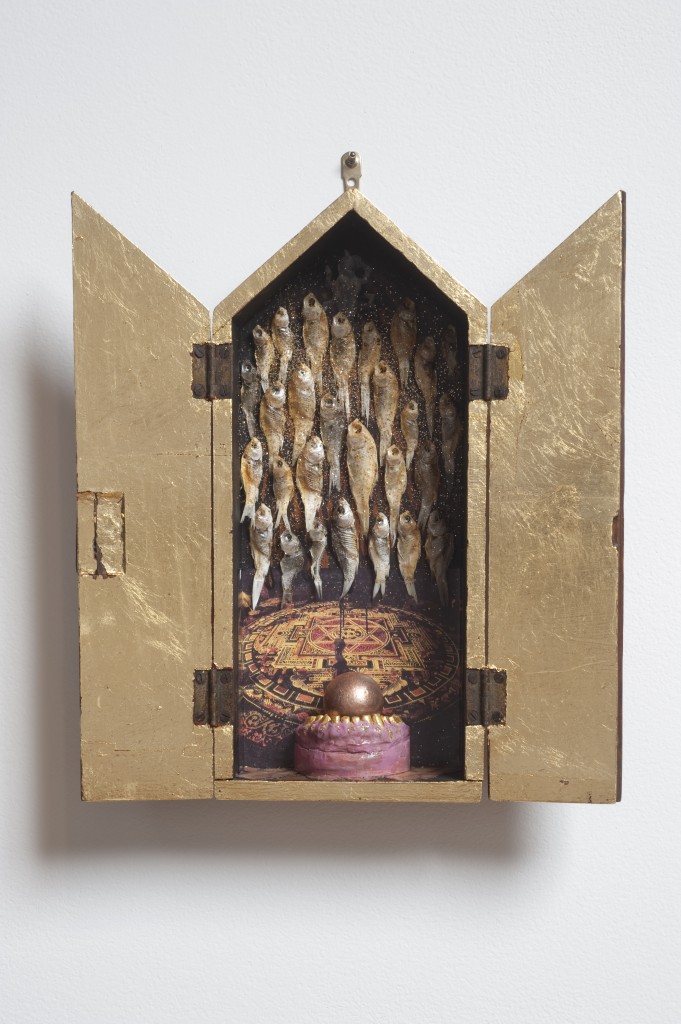
So we’ve run pretty long. I do still have one more little topic area and then we can come to a close.
Don’t hesitate to say more, more, more!
I see in the press materials that there is a participatory element to the Rubin exhibition and it reminds me of the temple at Burning Man, are you familiar with Burning Man?
We know of it and my younger daughter Genesse, she’s been something like 8 or …
Are you there?
***
At this point the system recording our conversation ran out of space and dropped out, cutting off our conversation. I called Genesis back, but felt felt that it was too much to ask them to go through the whole process of dialing in codes simply to get the answer to my last question. The question was regarding the act of ritual participation, and whether or not Genesis thought that simply getting individuals to participate in one ritual act could in and of itself lead to awakening our conscious to a higher level.
The answer was an immediate and resounding, “YES!” Genesis went on to describe an ideal way of living in intentional communities that would better allow for both the preservation and transmission of significant cultural information, as well as provide the necessary space for the creative growth of an individual. Of course, what Genesis did not know was that I was calling them from just such a space- an archive room at Synergia Ranch, which is an intentional community started in 1969 and fitting their description almost to the letter. We then spoke for yet another hour and a half, a conversation that will unfortunately remain off the published record.
Since the interview, I have been experiencing more and more synchronicities in my personal life and perceiving a more magical reality. Perhaps sharing this conversation might spark similar experiences in the reader. Better still, if you’re in NYC, get to the Rubin Museum and participate in Genesis’s exhibit, Try to Altar Everything, to experience the magic first hand.
Genesis thought that it would be helpful for RS readers to include the lyrics to ‘Greyhounds of the Future,’ mentioned above, so that the reader could see an example of the efforts herein described. See below:
GREYHOUNDS OF THE FUTURE
Memory is a clock
The aging mechanism of the mind
Memory is a clock
The aging mechanism of the mind
Mechanism ….mechanism
Turning gears …rocking …interlocking
Memories clocking
The aging mechanism of your mind
Memories tell us one thing
Everything must go
Memories tell us one thing
Everything must go
Memories tell us one thing
Everything must go
Memories tell us one thing
Everything must go
Everything must go
Nothing matters but the end of matter
Nothing matters but the end of matter
Nothing matters but the end of matter
Nothing matters but the end of matter
Be afraid to a point of formlessness
Be terrorized by a point of soundlessness
Be ex-dream to a point of powerlessness
Be afraid to a point of formlessness
Be terrorized to a point of soundlessness
Be ex-dream to a point of powerlessness
Be ex-dream
be ex-dream
Once upon a time there was a garden
This garden was destroyed by Word
Destroyed by language
Language became the first memory
Time was set in motion at this point
But the garden did not exist within TIME
Or language
It was an experiential neural projection
A Cathedral that worshipped its occupant
And that was your soul
Your s o u l
Your S O U L
The only thing you’ve got
And your soul well it represented the MIND
The mind preset without light
And there was nothing to reflect…no mirrors, nor shape
Nothing to fix this paricular Dreeeeeam
And you’ve got no anchors
You don’t know where you are
you don’t know if you’re really existing or you’ve
blown everything and you’ve got to become a Star star star
Nothing matters but the end of matter
nothing matters but the end of matter
nothing matters but the end of matter
Nothing matters but the end of MATTER
We are born sounds
Made names
Trapping matter with language
We perpetuate our tyranny
And drown in a flood of SPECULATION
A false communication hahahaha
Do you want to be immortal, reborn, outside of time ?
Come on child
Come through me
We must look for ways to transmit infinite alternative “realities”
And then maybe you have a choice of reality
You wanna stay alive
You wanna STAY alive
You don’t really want to die…
So make it REAL
Make whatever it is real
M O R E REAL than anything emasculating
That we inherit
Ohh you’ve not yet been corrupted have you?
Trivialised have you?
Lost in belief have you?
Ahhhhhh you’re in OUR singularity now
Nothing matters but the end of matter
nothing matters but the end of matter
nothing matters but the end of matter
Nothing matters but the end of MATTER
Every inherited moral construct
Every society every techno-patriotic political system
Betrayers of trade unions…believe us it exists
It exists..but it must be D E S T R O Y E D
As fast as its possible
You know…YOU know we make S P A C E !
Make space too be space
Memory is a clock
The aging mechanism of your mind
YOU can set the alarm
Memories tell us one thing
This thing must go
Memories tell us one thing
This thing must go
Memories tell us one thing
This thing has to go
Mass belief
Mass belief
Mass belief
Mass belief
Are you listening well?
Names are given in order to control
Names are given in order to control
Listen carefully
To reduce to comprehend the forces of nature
To demonstrate ownership and failure
This is the place to come
This is the race of the Greyhounds of a Future
G r e y h o u n d s of the Future
The race to name
The race to name O U R ..strategy
Strategy
We poor have grown to be richhhhh
And the rich have grown to be poor
AGAIN
Know that to re-enter immortality
We must ourselves become un-nameable
And we’re emptied of all sense
Just peeping
Memories tell us one thing
Everything must go
Memories tell us one thing
Everything must go
Memories tell us one thing
Everything must go
Memories tell us one thing
Everything must go


